Can you hike the Appalachian trail in three months? As it sounds ambitious, undertaking the hike requires careful planning, physical fitness, and mental preparedness. The Appalachian Trail stretches over 2,190 miles, traversing through 14 states from Georgia to Maine. While completing the trail in such a short time is feasible for some experienced hikers, it poses significant challenges that demand a strategic approach.

The Appalachian Trail Overview:
The Appalachian Trail is one of the longest continuous footpath’s in the world, offering diverse landscapes, from lush forests to rugged mountains. Hikers encounter varying elevations and terrains, making it a physically demanding journey. The trail is typically divided into several sections, each presenting its own set of challenges and rewards.
Average Hiking Time:
The average time to complete the entire AT is around 5 to 7 months. This duration allows for a more relaxed pace, giving hikers the opportunity to appreciate the scenery, interact with fellow hikers, and rest when needed. Attempting to cover the entire trail in three months requires covering an average of 24 miles per day, a pace that challenges even the most seasoned hikers.
Physical Fitness and Training:
Achieving such high daily mileage necessitates excellent physical fitness. Hikers should focus on building endurance, strength, and flexibility during their training. Cardiovascular exercises, strength training, and long-distance hiking with a loaded backpack are essential components of preparation.
Logistical Challenges:
Planning is paramount for a successful three-month hike. Efficient resupply strategies, gear maintenance, and emergency preparedness are crucial. Hikers must meticulously plan their route, considering factors such as weather conditions, water availability, and trail closures. Some sections of the trail are more remote than others, requiring careful consideration of resupply points and potential support from friends or family.
Weather Considerations:
The AT spans a variety of climates, from the hot and humid Southern states to the chilly and unpredictable weather in the North. Hiking in a condensed timeframe heightens the risk of encountering extreme weather conditions. Adequate gear for rain, snow, and varying temperatures is essential. Flexibility in the itinerary is also crucial, as adverse weather may require hikers to take rest days for safety.
Mental Preparedness:
The mental aspect of a thru-hike is often underestimated. The relentless physical exertion, isolation, and the monotony of daily routines can take a toll on a hiker’s mental well-being. Those attempting a three-month hike should be mentally resilient, ready to embrace both the highs and lows of the trail. The ability to adapt to unexpected challenges and setbacks is vital for success.
Benefits of a Faster Pace:
While completing the AT in three months poses numerous challenges, it also has its advantages. Hikers experience a sense of accomplishment, pushing their physical and mental boundaries. The faster pace allows for a more streamlined experience, potentially reducing the overall cost of the hike. Additionally, it may attract individuals with time constraints who still desire to experience the essence of the trail.
Drawbacks of a Faster Pace:
Attempting to cover extensive daily mileage can lead to physical injuries, exhaustion, and burnout. Rushing through the trail may result in missing out on the unique cultural and natural experiences that the AT offers. Hikers might find themselves constantly focused on the end goal, neglecting the journey itself.
Experienced Thru-Hikers’ Perspectives:
Interviews with experienced thru-hikers who have completed the AT in three months reveal a mix of opinions. Some attest to the satisfaction of achieving a faster pace, emphasizing the importance of discipline and efficient planning. Others caution against the toll it takes on the body and mind, suggesting a more relaxed approach for a richer hiking experience.
Tips for Those Considering a Three-Month Hike:
- Thorough Planning: Plan your route, resupply points, and rest days meticulously.
- Gear Optimization: Invest in lightweight and durable gear to minimize the physical strain.
- Physical Conditioning: Prioritize physical fitness, including both strength and endurance training.
- Flexibility: Be prepared to adapt to changing weather conditions and unforeseen challenges.
- Mental Resilience: Develop mental toughness to navigate the highs and lows of the journey.
Conclusion:
While hiking the Appalachian Trail in three months is an extraordinary feat, it demands a high level of physical, mental, and logistical preparedness. Thru-hikers must carefully weigh the benefits of a faster pace against the potential drawbacks, ensuring that the endeavor aligns with their goals and capabilities.


